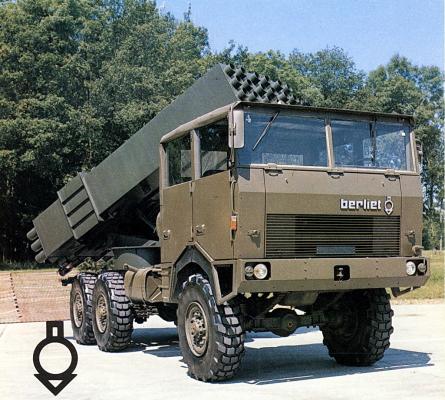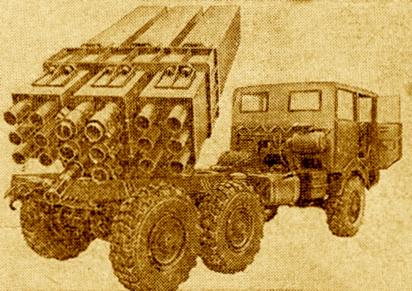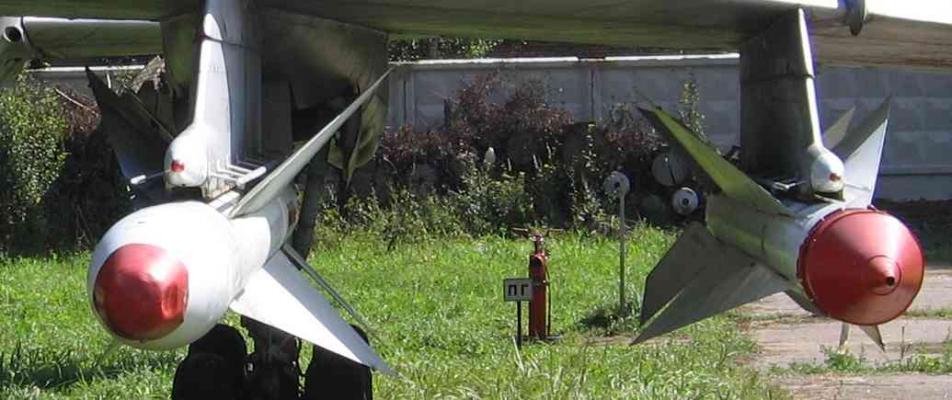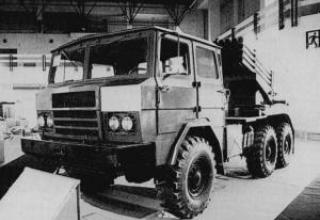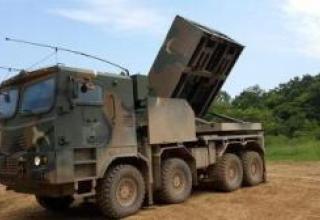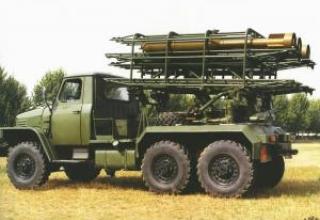The Rafale multiple launch rocket system has been developed since the early 70s by the private company Société Européene de Propulsion.
The artillery unit, mounted on the modified chassis of Renault TRM 9000 (6×6), consisted of three identical modular containers. Each container included six tubular rails with a length of five meters. The weight of an unloaded guide package (possibly an artillery piece) was 2,000 kg, and the lifting and swiveling mechanism weighed 1,500 kg. The range of angles of elevation was from +14 to 52 degrees.
The guide had two guide grooves to give the initial rotational motion to the projectile.
NURS, which had flight-opening plumage and aerodynamic brakes, were to be used for firing. Structurally, the projectile prototype consisted of a fuse, a head end and a rocket part. The missile part was equipped with four stabilizer blades that opened when leaving the guide rail.
Aerodynamic brakes located in front of the stabilizer unit were used for firing at ranges below 18,000 meters. Thanks to three sets of aerodynamic brakes with different surface areas, it was possible to shoot at three different ranges at elevation angles up to 15 degrees. The minimum projectile range when using aerodynamic brakes was 10000m, and without them 18000m. Unlocking of the aerodynamic brakes was provided remotely from the fire control panel located in the cockpit of the combat vehicle before launching, and opening of the brakes when the projectile leaves the guide rail.
The fire control panel was designed both for rocket launches and for pre-launch checks. Before firing, two hydraulic jacks were extended on both sides of the fighting vehicle.
The cassette head units were equipped:
- An anti-personnel variant with 35 combat elements weighing 350g each, 42mm in diameter and 360 ready-made steel balloons.
- anti-tank version with 63 cumulative warheads weighing 190 grams each.
- anti-tank version with five anti-tank mines.
Opening of the cassette head unit casing and ejection of combat elements was performed at a height of 700m (see photo).
The spacing between the projectiles discharged from the rails was 0.5 seconds. The full salvo time of the 36 shells was no longer than 18 seconds. The recharging time was about 15 minutes.
According to Jane's Armour and Artillery 1982-83. - P. 667., Société Européene de Propulsion carried out work on the artillery unit with 30 rails, which was mounted on the modified chassis of Renault TRM 9000 truck with 6×6 wheel configuration. The configuration of the guide package was three rows of ten pipes each (see photo1, photo2).
Scheduled date of adoption of the Rafale system in service - 1981 - 1982.
It is most likely that the system did not enter into service with the French Army because of the work on the MLRS and its further introduction into service.
Composition:
The K-80 missile ("item 36") was designed according to the normal aerodynamic scheme (see projections).
The hull consisted of five compartments. The front compartment of the R-4R missile housed a semi-active homing radar head PARG-10VV (R-4MR - PARG-15VV). R-4T missile was equipped with a nitrogen-cooled thermal GSN T-80NM "Rubezh", which allowed the attack in the rear hemisphere of the target with a 3/4 angle in the horizontal plane. The R-4MT was equipped with the improved thermal GSN T-80NMD.
PARG-10BV used the conical scanning method to measure angular misalignment. The advantage of this method is simplicity of construction, but this method is not protected from amplitude interference, which can be easily combined for the purpose. With a scan frequency known to the enemy, the amplitude interference knocks the head out of tracking mode. Negative effects on the interference immunity of RGS were caused by the use of automatic gain control associated with the application of conical scanning. Random spread of scanning frequencies required the use of amplitude modulation of the interference spectrum. Naturally, the disturbance was reduced and there were no tracking disruptions, but the spans caused by the disturbance were unacceptably large. In order to increase the interference immunity, a random scanning frequency was introduced into the RGS from one copy to another. This was to force the adversary to widen the spectrum of the modulating signal and thus reduce the spectral density of the influence determining the span variance. In PARG-15VV RGS (P-4M missiles) cone scanning was organized by electronic switching of the beam position relative to the optical axis of the antenna by random law. Due to a very wide range of rapprochement velocities of the missile with a target (from 200 to 1600 m/sec) before starting the CNS was introduced into the hemisphere, indicating the attack of the target in the front or rear. The target was captured by the homing heads before launch when the missile was located on the launcher. The homing method is proportional approach.
In the second compartment were located: radio detonator RV-80 with the safety executive mechanism I-60-80 (on the rocket R-4T used an optical fuse NOV-80N), shrapnel and blast warhead weighing 53.6 kg, autopilot APR-80 and ampoule battery. The combat unit contained 29 kg of explosives and at detonation provided formation of 2400 fragments weighing 6g.
The third compartment accommodated a solid fuel engine PRD-84. It was equipped with a ballistic fuel charge RNDSI-5K weighing 121 kg, made in the form of a checker with a diameter of 0.288 m, length 1.269 m with a cylindrical channel diameter of 68 mm. The total thrust pulse in ground conditions was 24500 kgf. The P-4M missile was equipped with the modified PRD-84M engine.
In the tail of the rocket, around the elongated gas duct of the engine nozzle along the longitudinal axis of the rocket were numerous cylinders of pneumatic system, and behind them - steering machines drive the aerodynamic rudders.
The triangular wing had a considerable area and a large angle of sweep along the front edge (75°) with zero angle along the rear. Low load on the wing, combined with high energy-efficiency provided implementation of transverse overload of the missile to 21 units. All channels were controlled by differential deflection of the all-terrain rudders.
Missiles were suspended on rods to the launchers ACU-128, which had special rods, limiting the roll of missiles, preventing from "rubble" during the launch and impact on the pylon.
Characteristics:
| Data from a prototype rocket projectile | |
| Caliber, mm | 145 |
| The length of the projectile, mm | 3200 |
| Jet weight, kg | 78 |
| Weight of the head end, kg | 19 |
| Maximum range, m | 30 000 |
| Guide projectile velocities, m/s | 100 |
| Maximum flight speed, m/s | 1100 |
| Rocket engine running time, sec. | 4 |
Testing:
From September 1 to November 28, 1945, the Nb.W.42 trophy mortar was tested at the Red Army State Automobile and Space Administration. The tests were carried out on the basis of the order of the Deputy Chief of SAKP, Major-General of the Engineering and Artillery Service of Serebryakov under the program of the range - SAKP task №4410.
In the report No 0116 dated 19.1.46 the description of the device and operation of the Wgr.42 mine, L.J.gr.Z23nA fuse and the mortar were given. Data on the heap and range, as well as theoretical calculations of internal and external ballistics are given. In addition, the report contains the results of analysis of the hull materials and equipment. The test manager was Captain Lerner.
The purpose of the tests was to determine:
- basic characteristics of the mortar and the mine Wgr.42 /description of the device, operation and purpose/.
- Intraballistic characteristics Wgr.42 /powder gas pressure and charge burn time/.
- aerodynamic characteristics Wgr.42 (wind tunnel blowing).
- The impact and maximum mine speed and the nature of mine buildup in the active area.
- Maximum range at 10°, 20°, 30° and 45° elevation angles.
- The mine's blast and fragmentation effect on the target.
- the system's strength, stability and rate of fire.
When measuring five minutes on centering belts, the projectile caliber was 214 mm, so the report suggested "counting the caliber not 210 mm as usual, but 214 mm".
The conclusions of report No. 0116 were as follows:
- The 210 mm Wgr.42 rocket projectile with the M-13UK missile was characterized by simplicity, cheapness and availability of materials that were used for its production. It was noted that the Germans considered it possible for missile chambers to allow deformation at maximum pressure beyond the elastic limits, i.e. the chambers were calculated not on the elastic limit, but on the temporary resistance to rupture with a margin of strength of the order n=1.5.
- Manufacturing of dinitroglycol powders for rocket charges had advantage in comparison with manufacturing of nitroglycerine powders. As glycol was based on cheap raw material base (vegetable oils), and glycerin was mainly produced from animal fats.
During the study of the mine, it was disassembled into structural elements. See their photos: photo 1, photo 2, photo 3, photo 4, photo 5, photo 6, photo 7.
From August 8th till August 13th 1945 at the State Mine Stockpile of Ukraine there were conducted shooting to determine experimental data for drawing up tables of shooting. Shots were fired at an elevation angle of 10°, 20°, 30° and 45° (maximum possible elevation angle).
The mortar was simultaneously loaded with 5 shells. The mortar was fired in single shots. The charge was corrected after each shot, and the shoot down rate was insignificant. Due to lack of German mortar sight, side aiming was made with MP-41 sight.
As a result of tests it was received:
- The puchiness and range of the 210 mm Wgr.42 missile did not differ from the characteristics of the domestic M-13UK projectile. When the angle of Ө decreases (elevation angle) the heap drops sharply especially in range: gri Ө=10° the range of 2650m and the WDX = 1/17 was obtained; WDX = 1/58, at Ө=45° the range of 8000 m and the WDX = 1/88; WDX = 1/76.
- The effect of the Wgr.42 mine on the target was undoubtedly more powerful than that of the M-13UK, as the 210mm projectile carried 9.27 kg of explosives, while the M-13UK carried 4.55 kg. However, the Wgr.42 has a smaller fill factor /WB to passive weight ratio than the M-13UK. The M-13UK had a filling ratio of 13% and Wgr.42 had a filling ratio of 10%.
- The design of the Wgr.42 mine was characterized by the simplicity, affordability and accessibility of the materials used in its manufacture.
- Calculation of internal ballistics showed the following results: at charge temperature - 40°C the pressure in the chamber was equal to 106 kg/cm2, at charge temperature +40°C the pressure was equal to 325 kg/cm2. This gave grounds to suppose that the rocket charge will work at low temperatures and will not break the chamber at high ones.
- The chemical composition and physical characteristics of the gunpowder rocket charge did not differ from glycol powders, which were adopted in German artillery. Powder strength and caloric value were of the same order as M-13UK rocket charges, but the use of glycol undoubtedly extended the raw material base of the powder production.
- The design of the 210-mm 5-barrel Nb.W.42 mortar carriage did not differ from that of the 150-mm 6-barrel Nb.W.41 mortar carriage.
- The maneuverability and ease of operation are satisfactory, but the power of the 210 mm mortar salvo is about 1.5 times smaller than that of the BM-13. For one salvo of 5-barrel mortar ejected 46 kg ВВ, and installation BM-13 - 73 kg ВВ.
It was concluded that the design of the 210 mm Nb.W.42 rocket launcher and its projectile was found to be successful, both in combat and operational terms.
The mortar was disassembled into its structural elements during its study. See their photographs: photo 1, photo 2, photo 3, photo 4, photo 5, photo 6, photo 7, photo 8.
Sources:
- О. Суров. Реактивные системы залпового огня. // Зарубежное военное обозрение. – № 4, 1980.
- Реактивные системы залпового огня – Франция. // Экспресс-информация. – № 2 (422). – 1983. – C. 5.
- Jane's Armour and Artillery 1982-83. - P. 667. (Из фонда Российской Национальной Библиотеки (РНБ), Россия, г. Санкт-Петербург/микрофильм).
- https://d.radikal.ru/d26/1802/29/570e7bbb0da2.jpg
